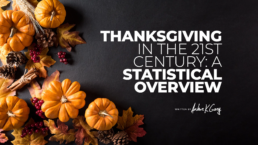Thanksgiving, a cherished American tradition, has witnessed subtle yet significant changes in its celebration patterns in the 21st century. As we delve into the statistics surrounding this age-old holiday, it becomes evident how evolving socio-cultural trends, technology, and even global events have influenced the way we celebrate Thanksgiving.
Thanksgiving Travel:
- Early 2000s: In the early years of the 21st century, around 35–40 million Americans traveled during the Thanksgiving holiday, with the vast majority using cars.
- 2019: According to the American Automobile Association (AAA), over 55 million Americans traveled more than 50 miles from home for Thanksgiving, marking the second-highest travel volume since AAA began tracking in 2000.
- 2020: The COVID-19 pandemic saw a sharp decline, with only around 34 million people traveling — the most significant one-year decrease since the Great Recession in 2008.
The Feast:
- Traditional vs. Alternative: While turkey remains the central dish, with about 90% of Americans feasting on it during Thanksgiving, the 21st century saw a rise in alternative choices. By 2020, 5% of US consumers reported considering a plant-based turkey alternative.
- Organic and Local: A 2019 survey showed that nearly 30% of Americans opted for organic food items for their Thanksgiving dinner, reflecting the larger trend of organic consumption in the US.
Shopping and Black Friday:
- 2000s: The 2000s witnessed the burgeoning trend of Black Friday shopping, with stores opening early on the day after Thanksgiving.
- 2010s: The advent of e-commerce shifted the focus to Cyber Monday, with online sales hitting $7.9 billion in 2018.
- 2020: Due to the pandemic, many retailers spread out their deals throughout November to reduce crowds. As a result, online sales on Black Friday reached a record $9 billion.
Technological Integration:
- Parade Streaming: The Macy’s Thanksgiving Day Parade, a beloved tradition, saw its viewership patterns change. By 2019, over 20% of viewers chose to stream the parade online.
- Virtual Celebrations: 2020, amidst the pandemic, saw a surge in virtual Thanksgiving celebrations. Nearly 35% of Americans reported using video conferencing platforms to connect with family and friends.
Cost of Thanksgiving:
- Early 2000s: The average cost for a Thanksgiving dinner for ten hovered around $35-$40.
- 2019: The American Farm Bureau reported the average cost was $48.91.
- 2021: Despite economic challenges, the cost saw a marginal increase, settling at around $50 for ten people.
Social Awareness:
- The 21st century saw increased recognition of Native American perspectives on Thanksgiving. By the 2010s, several cities began acknowledging the day as “Native American Heritage Day” or “Indigenous Peoples’ Day.” By 2020, a survey revealed that 30% of American educators incorporated Native American perspectives into their Thanksgiving curriculum.
In conclusion the statistics reveal a dynamic evolution of Thanksgiving celebrations in the 21st century. From the dishes we eat to the way we shop and the manner we choose to connect with loved ones, each aspect mirrors broader trends in society, technology, and global events. As we continue forward, Thanksgiving promises to remain a deeply cherished tradition, even as its modern iterations adapt to the times.





